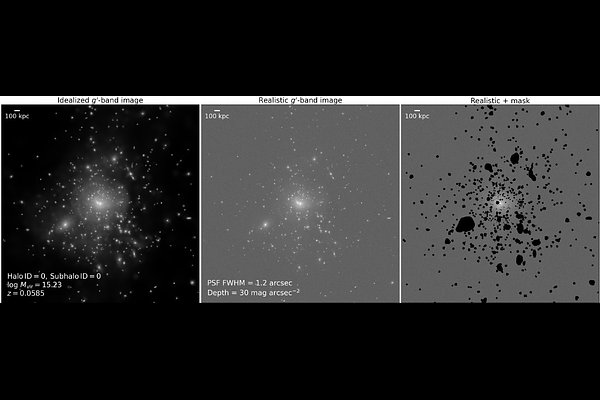Photometric analysis of the intracluster light in the TNG300 simulation and wide-field observations

Photometric analysis of the intracluster light in the TNG300 simulation and wide-field observations
Daniel Montenegro-Taborda, Vicente Rodriguez-Gomez, Vladimir Avila-Reese, Bernardo Cervantes-Sodi, Matthias Kluge, Aditya Manuwal, Annalisa Pillepich, Lars Hernquist
AbstractWe present a robust, apples-to-apples comparison between the photometric properties of the intracluster light (ICL) in the TNG300 magnetohydrodynamic cosmological simulation and those in Wendelstein Wide Field Imager (WWFI) observations. This is accomplished by generating synthetic $g'$-band images of 40 massive ($\log\left(M_{\rm 200, crit}/{\rm M}_{\odot}\right) > 14.5$) TNG300 clusters at $z \approx 0.06$, closely mimicking WWFI observations, and then performing identical photometric calculations on the synthetic and real images. Importantly, we apply the same observationally motivated satellite-masking procedure to both data-sets, which effectively removes any possible biases introduced by the halo finder. We first analyze the light distribution of the `smooth' stellar component of each cluster, composed of the brightest cluster galaxy (BCG) plus the ICL, and find that it tends to be about twice as extended in TNG300 than in observations, while also being approximately 1 $g'$ mag arcsec$^{-2}$ brighter. We then quantify $f_{\rm ICL}$, the ICL fraction relative to the BCG+ICL, by considering several ICL definitions: (i) the light dimmer than a surface brightness cut at 27 $g'$ mag arcsec$^{-2}$, (ii) the excess light over a de Vaucouleurs profile, (iii) the light beyond twice the half-light radius ($2 r_{\rm half}$), and (iv) the light beyond a fixed circular aperture of 30, 50, or 100 kpc. For most definitions, the median $f_{\rm ICL}$ is consistent between simulation and observations. However, the observations exhibit larger scatter in $f_{\rm ICL}$, which we attribute primarily to observational uncertainties in the total BCG+ICL luminosity rather than `true' cluster-to-cluster variation in the real Universe. We also find that most methods yield median $f_{\rm ICL}$ values near 0.3, which is consistent with a BCG/ICL transition radius around $2 r_{\rm half}$.